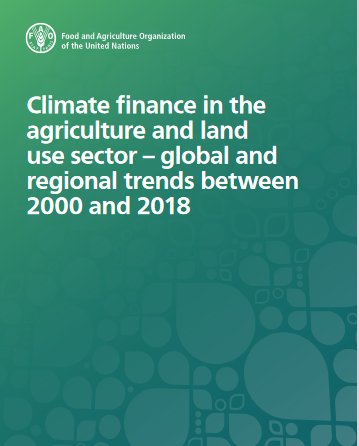🌿 COP 30 - Building a Greener Tomorrow
The 30th UN Climate Change Conference (COP 30) is taking place in Belém, Brazil. Stay informed about global climate actions, negotiations, and live sessions from 10 – 21 November 2025.
Get Updates
Climate finance in the agriculture and land use sector – global and regional trends between 2000 and 2018

Files
Date
January, 2024Author(s)
- Olga Buto
- Giulia Maria Galbiati
- Natalia Alekseeva
- artial Bernoux
Abstract
Climate finance is a fundamental element of the global development agenda and has been accelerating in recent years. Yet between 2000 and 2018 the share of global climate finance in the agriculture and land use sector has decreased, passing from an average of 45 percent of the total flows at the beginning of the millennium, to 24 percent in 2013 where it has since stayed. The total sum of contributions to the agriculture and land use sector between 2000 and 2018 amounted to USD 122 billion, representing 26 percent of the global climate finance flows to all sectors. This report aims to increase the understanding of the climate finance trends in the agriculture and land use sector at global and regional scale, providing insights for UN agencies, international finance institutions, national governments of both donor and recipient countries, and governmental and non-governmental stakeholders. By looking at the main features of climate finance, including the source and geographical destination of resources, climate objectives and gender sensitivity, the analysis establishes the key trends in agriculture and land use sector in the period 2000-2018. In addition, it identifies gaps which may affect the stagnated trend relative to other sectors. This study focuses on the quantitative analysis of data available in the climate-related development finance database of the Organization for Economic Co-operation and Development’s (OECD) Development Assistance Committee (DAC). Further qualitative analysis could build on this work to research the different trends that influence climate finance distribution. Type of climate finance Climate finance provided to the agriculture and land use sector is predominantly concessional and developmental, meaning that it has more generous terms than market ones, and is primarily aimed at economic development (89 percent). Climate finance flows to other sectors rely less on this financing type (71 percent), which might indicate that they are more capable of attracting diverse types of climate lows which are not concessional and not primarily developmental. Main providers and climate objectives Despite calls for diversification, DAC members are still the main providers of climate finance. The allocations from the private sector are marginal and mainly directed to Global and Regional projects. The DAC members direct 33 percent of their resources to adaptation and 36 percent to mitigation in the agriculture and land use sector, compared to 23 percent and 59 percent respectively to all sectors at the global level. For the multilateral development banks, the difference between the climate objective of finance is even more accentuated, with 66 percent of contributions going to adaptation and 30 percent going to mitigation in the agriculture and land use sector, compared to 24 percent and 74 percent, respectively, to all the sectors at the global level. Regional findings When looking at region-specific climate finance allocations in the agriculture and land use sector, the principal recipients in the assessed period were countries in Africa and Asia, attracting 30 percent and 32 percent of flows respectively. For all regions, 2010 marked the first year of reported allocations to climate change adaptation in the agriculture and land use sector . There was an overall decrease in allocations to mitigation in agriculture and land use sector (allocations to climate mitigation were dominant only in Europe), and strong preference to allocate to projects with a cross-cutting objective. In the assessed period, Asia attracted more diverse types of financial flows (including non-concessional and from Multilateral Development Banks (MDBs), compared to other regions. A loan was the dominant financial instrument for climate finance allocations in agriculture and land use sector in Asia, as opposed to a grant in Africa. Climate finance to the most vulnerable Of the USD 3.6 billion of climate finance in the agriculture and land use sector allocated to Small Islands Developing States (SIDS), the Caribbean SIDS received the largest share, followed by the Pacific and the Atlantic, Indian Ocean, Mediterranean and South China Sea (AIMS) SIDS. The resources were almost equally distributed among the different climate objectives in the majority of the SIDS sub-regions. Climate change adaptation was the dominant climate objective in the Pacific SIDS and the Caribbean SIDS, attracting USD 500 million and USD 746 million worth of allocations respectively. Between 2000 and 2018, the Least Developed Countries (LDCs) received a total of USD 32 billion to support activities in the agriculture and land use sector, with DAC members as main resource partners. The majority of contributions were directed to climate adaptation activities. The sector specific allocations were predominantly in the agriculture development sub-sector, environment and biodiversity and food security sub-sectors in all the regions. The climate finance to crop production, livestock and fisheries remained marginal between 2000 and 2018. Gender lens Around 52 percent of climate finance allocated to Africa was qualified as ‘principal’ or ‘significant’ for gender issues. In all other regions, the share of the ‘not significant’ gender marker was between 35 percent in Asia and 60 percent in the North Africa and Middle East, which means that the funded activities did not target gender equality. In Africa, Asia, America and Europe, more than one fifth of all climate finance was not reviewed from a gender perspective and the gender marker was not defined. Whereas in North Africa and Middle East, only 2 percent of activities remained undefined, and the vast 98 percent had the gender marker. All climate finance should be subject to gender screening, and the assessment points to further effort needed for the agriculture and land use sector, particularly considering the acceleration in the global climate finance flows.
Citation
Buto, O., Galbiati, G.M., Alekseeva, N. and Bernoux, M. 2021. Climate finance in the agriculture and land use sector - global and regional trends between 2000 and 2018. Rome, FAO. https://doi.org/10.4060/cb6056en
Publisher
Food and Agriculture Organization of the United Nations Rome, 2021
Rights Holder
© FAO, 2021
URI
https://knowledgehub.pksf.org.bd/collections/MGVuR2pQajdKdGZSRTd6T1oyaFFlQT09
